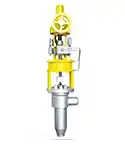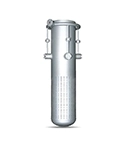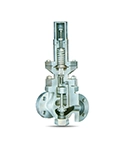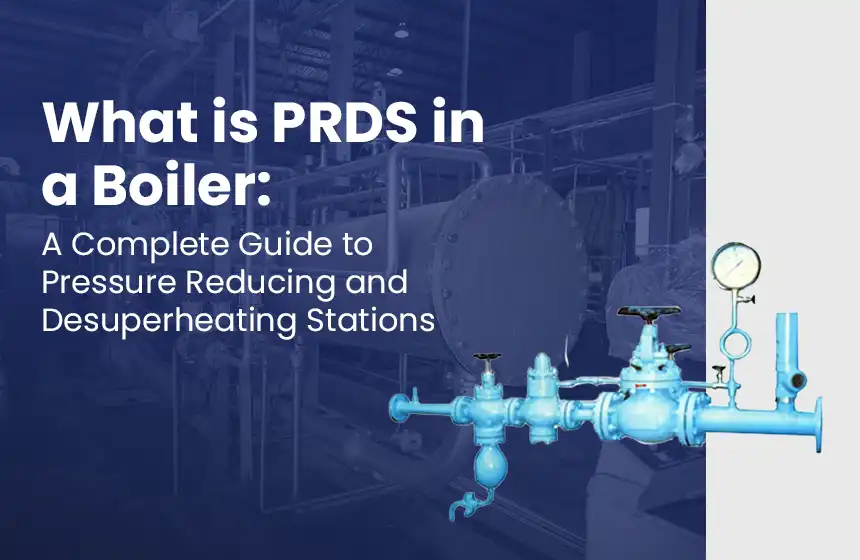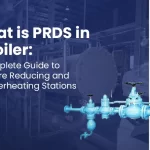
What is PRDS in a Boiler: A Complete Guide to Pressure Reducing and Desuperheating Stations
October 14, 2025
What is PRDS in a Boiler: A Complete Guide to Pressure Reducing and Desuperheating Stations
October 14, 2025What is a PRDS in Power Plants: A Complete Guide to Pressure Reducing and Desuperheating Stations
Steam drives turbines and produces electricity in any power plant. However, before this steam reaches different sections of the plant, it needs to be at the right pressure and temperature. If the steam pressure is too high, it can damage the equipment. On the flip side, if the steam pressure is too low, it can drop the efficiency. Here is where Pressure Reducing and Desuperheating Station plays a major role. This blog explains what a PRDS in a power plant is, how it works, and the importance of maintaining safe and efficient operation.

What is PRDS in Power Plant?
Pressure Reducing and Desuperheating Station in the power plant (PRDS in power plant) is the system that is used to control the pressure and temperature of the steam before it is sent to various process units or turbines.
In simple terms, it is the device that ensures steam has the right pressure and the right temperature for safe and efficient use.
What is the Importance of PRDS in Power Plants?
Generally, in thermal power plants, steam is generated in boilers at very high pressure and temperature. However, not all parts of the plants can handle that extreme steam.
For example, the turbine may require steam at 150 bar and 540°C, and the process line may need steam at only 40 bar and 250°C. The pressure reducing and desuperheating station in a power plant ensures that each section receives steam that is best suited for its purpose.
If there is no PRDS in the power plant, your system could face:
- Pipe bursts because of the high pressure
- Equipment failure
- Inefficient steam usage can cause high fuel costs
What is the Working Principle of PRDS in Thermal Power Plant?
The PRDS in thermal power plant usually work in two stages.
| Stage | Function | Main Components |
|---|---|---|
| 1. Pressure Reduction | It reduces high-pressure steam from the boiler to the required pressure. | The main components used in it are the Control Valve or Pressure Reducing Valve (PRV) |
| 2. Desuperheating | In this stage, the steam of the temperature is reduced to the required level. | In this stage Desuperheater Nozzle or Spray Water Control Valve is used. |
Let’s understand the step-by-step process.
- First, high-pressure steam from the boiler enters the PRDS unit.
- The PRV controls and lowers the steam pressure as per system demand.
- Now, the steam pressure is reduced, but it is still too hot for downstream equipment.
- The desuperheating section sprays finely atomized water into the steam through a desuperheater nozzle.
- It converts some steam heat into water vapor, which reduces the temperature without affecting steam quality.
Now, the steam with the right pressure and temperature is ready for safe use in various plant processes.
Which Components do You Find in the Pressure Reducing and Desuperheating Station in a Power Plant?
Here are the main components that you will find in the Pressure Reducing and Desuperheating Station in a power plant.
| Component | Function |
|---|---|
| Pressure Reducing Valve | It reduces high-pressure steam to the required level. |
| Desuperheater | The desuperheater injects cooling water to control steam temperature. |
| Control Valves | It regulates pressure and flow automatically. |
| Temperature and Pressure Sensors | It constantly monitors system conditions. |
| Strainers and Separators | They remove impurities or moisture from steam. |
| Safety Valves | It prevents overpressure situations. |
All these components work together and ensure the steam supply is reliable, stable, and safe for continuous operation.
What are the Common Problems Without a PRDS?
If there is no PRDS in power plants, many problems can occur.
- Downstream equipment can overheat because of the high steam temperature.
- It can cause pressure shocks, which can damage valves, seals, and pipelines.
- Usually, inconsistent process output occurs in auxiliary operations.
- It wastes fuel because unregulated steam causes a poor energy balance.
All these issues not only increase operational costs but also affect the plant safety and reliability.
What are the Benefits of Using PRDS in Thermal Power Plants?
The PRDS in thermal power plants offer the following benefits.
- It offers a stable and well-controlled steam supply for smooth operation.
- The optimal steam utilization reduces fuel consumption.
- PRDS in thermal power plants prevents thermal and pressure-related damage.
- The advanced control valves and sensors ensure reliable operation.
- It reduces wear and tear on turbines and process lines.
PRDS Application Examples in Power Plants
PRDS in thermal power plants are usually used in the following applications.
| Application | Usage |
|---|---|
| Feedwater Heaters | It controls the steam supply for water pre-heating. |
| Deaerators | In deaerators, PRDS is used to remove dissolved gases from the feedwater. |
| Auxiliary Steam Lines | It is used for startup, shutdown, or standby operations. |
| Process Heating | In process heating, PRDS is used for fuel oil heating or ash handling systems. |
In short, each application requires precise control, and PRDS delivers it properly.
Final Thoughts
A pressure reducing and desuperheating station seems like another equipment, but reality is different. It plays a major role in maintaining the reliability, safety, and efficiency of every power plant.
PRDS in power plants ensures that every process receives steam at the right pressure and temperature. It protects equipment and improves plant performance.
At Vytal Controls, we specialize in designing and manufacturing custom PRDS for thermal power plants. Our solutions are built for precision, security, and long service life, which helps power and thermal plants operate at their best with minimum downtime and maximum efficiency.
Therefore, if you’re looking to upgrade or install a PRDS in your power plant, contact us today. We are the trusted name in the industry for smart, reliable, and energy-efficient steam control solutions.


